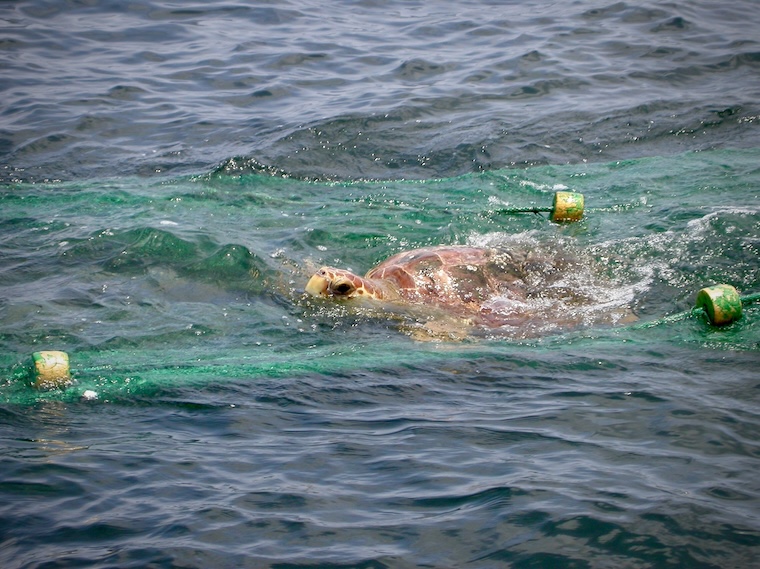Campus News
Industrial fishing poses greater risk to marine life due to untracked activity, UC Santa Cruz researchers find
A new study led by a scientist at UC Santa Cruz’s Institute of Marine Sciences finds that blue whales, tunas, and other top predators in the northeast Pacific Ocean face greater risk of harm from industrial fishing than previously thought.

Screenshot
A new study led by a scientist at UC Santa Cruz’s Institute of Marine Sciences finds that blue whales, tunas, and other top predators in the northeast Pacific Ocean face greater risk of harm from industrial fishing than previously thought.
The team behind the study, published on March 6 in Science Advances, began with previously collected data on when fishing vessels intentionally turned off their location-tracking system or lost their signal due to technical issues. The study’s authors then overlaid the habitats of 14 large marine species – including endangered and critically endangered ones like blue whales and leatherback turtles – and found the risk to these creatures increased overall by nearly 25% when they accounted for the presence of these so-called “dark vessels.”
“We know that many sea creatures, including endangered species, are killed by overfishing, accidental catch, and entanglement in fishing gear,” said Heather Welch, project scientist at UC Santa Cruz’s Institute of Marine Sciences. “Similar estimates of risk are used in species stock assessments to decide their populations and catch limits. For example, how many tuna can we take out of the water? Well, if the risks are higher than we think, catch limits might need to be lowered.”
Why fishing vessels go dark
The researchers examined five years of data from fishing vessel location devices collected by Global Fishing Watch, which advocates for full transparency in fishing activity worldwide through national and regional adoption of regulations mandating the use of automatic identification systems (AIS) on all industrial fishing vessels. Patchwork AIS requirements set by different nations mean that AIS disabling can be legal on the open ocean.
In this study, the majority of untracked fishing activity was due to AIS being disabled due to technical issues like poor satellite coverage or signal interference. And similar to how anyone can turn off location tracking on their mobile phone, fishing vessels can intentionally take AIS offline whenever they wish to hide their presence.
Sometimes, turning off location tracking is necessary, like when a vessel is in waters where pirates are known to be. It isn’t necessarily illegal, either. For instance, U.S. fishing vessels only need AIS on when they are within 12 nautical miles from shore, Welch explained. Still, the study’s authors insist that fishing vessels should have AIS enabled whenever possible, for both transparency and safety.
“We have these huge blind spots around what humans are doing at sea,” Welch said. “Imagine, for instance, if we didn’t know where 19% of our airplanes were at any given time. It would be chaos.”
Shedding light with data
In their previous study using the AIS dataset, the researchers identified over 55,000 suspected intentional disabling events between 2017 and 2019, obscuring nearly 5 million hours of fishing vessel activity. More than 40% of the total hours obscured by suspected AIS disabling occurred across four hotspots, three of which are areas of concern for illegal fishing: the Northwest Pacific and areas adjacent to the Exclusive Economic Zones of Argentina and West African nations. These areas contain rich fishing grounds with limited management oversight.
However, the final hotspot – located in the Bering Sea – is one of the most intensively managed and monitored fishing grounds in the world. Intentional disabling in these waters is done to avoid alerting competitors to the locations of high-quality fishing grounds.
At a time of heightened concern about overfishing and the resulting massive amounts of bycatch, the authors say that underestimated risk to sensitive species is even more alarming.
In an article she wrote for The Conversation, Welch discusses the overlap between where industrial fishing takes place and top-predator habitats: Observable fishing activity was found in over 45% of California sea lion habitat and in nearly one-third of salmon shark habitat. When dark vessels were accounted for, estimates of risk to those species increased by 28% and 23%, respectively.
Implications for policy and openness
In light of these findings, regulators and agencies may want to revisit the commercial-fishing limits and endangered-species designations they oversee. The study also underscores the need for better and more accessible data on human-wildlife interactions at sea. Aside from AIS, the other main sources of data in the United States are the national Vessel Monitoring System, observer data, and logbooks. But these are confidential and rarely shared across flag states.
Other co-authors on the study from UC Santa Cruz include Assistant Researcher Megan Cimino and Associate Researcher Elliott Hazen – both adjunct professors at UC Santa Cruz. Collaborators from Global Fishing Watch included Tyler Clavelle, Timothy White, and David Kroodsma.
The study was funded by the National Oceanic and Atmospheric Administration’s Office of Law Enforcement and inspired by NOAA’s strategic plans on combating illegal, unreported, and unregulated fishing activities.